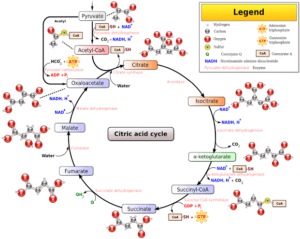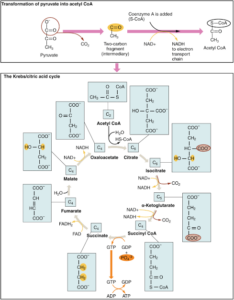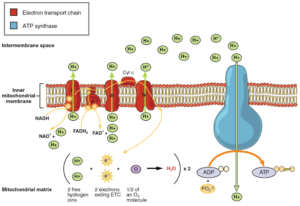Is Krebs cycle aerobic or anaerobic, a very tricky question. Because the Krebs cycle itself does not require oxygen but in absence of oxygen the process will be stopped. So here we are going to find out the answer of is Krebs cycle aerobic or anaerobic.
The Krebs cycle process doesn’t require any oxygen molecule itself. But after ending when the reductant molecule undergoes electron transport chain, O2 serves as the last electron acceptor. In absence of O2 the whole process along with Krebs cycle would be jammed. That’s why though Krebs cycle doesn’t require O2 itself, it is an aerobic respiration process.
Famous German biologist, biochemist Sir Hans Adolf Krebs and William Arthur Johnson first identified the process in 1937. According to the name of Sir H. A. Krebs , the process is named Krebs cycle. The cycle is also known as Citric Acid Cycle because at the beginning of this process the acetyl-CoA reacts with oxaloacetate and produces Citric Acid.
The citric acid (6-carbon molecule) has three carboxylic groups (- COOH) in it. This is why the cycle is also called TCA cycle or Tricarboxylic acid cycle. The Krebs cycle is 8 enzymes mediated reactions. The enzymes involved in Krebs cycle are Citrate synthase, Aconitase, Isocitrate dehydrogenase, α-ketoglutarate, Succinyl-CoA synthetase, Succinate dehydrogenase, Fumarase, Malate dehydrogenase, etc.
Besides small amounts of energy Krebs cycle produces reductants which later participate in the oxidative phosphorylation process. After completing one cycle 3 molecules of NADH, 1 molecule FADH2, 1 molecule GTP (or ATP), 2 molecules of CO2 are produced.

Is Krebs cycle aerobic or anaerobic from Wikimedia Commons
Does Krebs cycle occur in anaerobic respiration?
Though Krebs cycle doesn’t require oxygen it is exclusively an aerobic respiration method.
In anaerobic respiration process, the first step is the same as the aerobic respiration process, that is glycolysis. In the glycolysis process the Sugar molecule breaks into 3-carbon molecule pyruvate ( C3H4O3) and produces some energy (2 ATP). After that in anaerobic process due to absence of oxygen, the reductant NADH doesn’t undergo oxidative phosphorylation and the Krebs cycle process would also be hampered. For this reason Krebs cycle doesn’t occur in anaerobic mode.
Instead of Krebs cycle after the glycolysis process in anaerobic mode the molecules undergo lactic acid production or alcohol fermentation process and release small amounts of ATP (2 ATP).
In lactic acid production the sugar molecule first undergoes glycolysis and converts into three carbon molecule pyruvate ( C3H4O3) after that it breaks again to produce lactic acid and energy.
C6H12O6 → C3H6O3 + energy (2ATP)
In the alcohol fermentation process the sugar molecule undergoes glycolysis and converts into three carbon molecule pyruvate (C3H4O3), after that it breaks and converts into alcohol (Ethanol) and produces energy and carbon dioxide (CO2).
C6H12O6 → C2H5OH + CO2 + energy (2ATP)
Krebs cycle steps
Glycolysis is the first step in the respiration process after which the produced pyruvate comes into the mitochondrial matrix and is oxidized. After releasing a carboxyl group as carbon dioxide, It converts into acetyl-CoA. The acetyl-CoA is the only molecule which enters in Krebs cycle process at first. The Krebs cycle proceeds following several steps.
- Condensation between acetyl-CoA and oxaloacetate
- Isomerization of citric acid
- Decarboxylation of ispcitrate
- Oxidative decarboxylation of α-ketoglutarate
- succinyl-CoA to succinate
- Dehydration of succinate
- Hydration of fumarate
- Dehydrogenation of L-malate

Is Krebs cycle aerobic or anaerobic from Wikimedia Commons
Condensation between acetyl-CoA and oxaloacetate
At the beginning the acetyl-CoA produced by oxidation of pyruvate was associated with oxaloacetate ( OAA). It is an irreversible reaction in which citrate synthase involves and forms citrate and coA.
Isomerization of citric acid
It is a two step reversable reaction in which the enzyme aconitase cause dehydration of citrate and converts it into cis-aconitase. Following by the step the cis-aconitase undergoes rehydration and forms isocitrate.
Decarboxylation of isocitrate
It is also a two step reaction. At first the isocitrate dehydrogenase enzyme converts isocitrate to oxalosuccinate and NAD+ into NADH.
At the second step decarboxylation is facilitated by converting oxalosuccinate into α-ketoglutarate and releasing 1 molecule of CO2.
Oxidative decarboxylation of α-ketoglutarate
Just like the previous step, it is also an oxidation-reduction reaction. It is an irreversible reaction in which α-ketoglutarate dehydrogenase releases a carboxyl group or 1 molecule of CO2 and converts α-ketoglutarate to succinyl-CoA. In this reaction 1 molecule of NADH is produced.
Succinyl-CoA to succinate
It is the only step which causes phosphorylation of guanosine diphosphate and produces GTP molecules. This step is facilitated by the enzyme succinyl-CoA synthase which converts Succinyl-CoA into succinate and produces GTP.
Dehydration of succinate
In this step succinate dehydrogenase, dehydrogenated succinate into the
Fumarate. In this reaction FAD serves as electron acceptor and converts into FADH2. It undergoes the electron transport chain and produces 2 molecules of ATP at the end.
Hydration of fumarate
It is a reversible reaction. The enzyme fumarase hydrates fumarate and converts it into L-malate.
Dehydrogenation of L-malate
It is also an oxidation-reduction reaction, in which L-malate dehydrogenase is involved. The L-malate dehydrogenase coverus L-malate into oxaloacetate and also converts NAD+ into NADH reductant. It is the last step of the cycle after that The NADH participate in electron transport chain mechanism and produce energy. The oxaloacetate allows repetition of the cycle once again with the association of acetyl-coA.
To know more read our article on Active Transport Examples: Primary ,Secondary with Explanations
Is Krebs cycle oxidative phosphorylation?
In the aerobic respiration process the whole mechanism undergoes oxidative phosphorylation at the last step and releases energy by breaking bonds. In this process NADH converts into NAD and the oxygen molecule serves as the last electron acceptor molecule.
The Krebs cycle is not the oxidative phosphorylation process, both of them are different from each other. The oxidative phosphorylation takes place at the end of Krebs cycle process. Where the Krebs cycle produces Carbon Dioxide or CO2, Adenosine triphosphate or ATP and reductant NADH (Nicotinamide adenine dinucleotide) and FAD (Flavin adenine dinucleotide). The oxidative phosphorylation process produces energy molecules or the ATP by reducing NADH into NAD.

Oxidative phosphorylation process from Wikimedia Commons
Is Krebs cycle catabolic or anabolic?
Metabolic processes in which complex molecules break down and convert into smaller units and energy releases are catabolic reactions. Metabolic process is energy requiring reaction, in which complex molecules are constructed using smaller molecular units.
In Krebs cycle it is seen that from oxidation of acetyl-CoA, GTP, NADH, FADH2, etc produces just like catabolic reaction. In other hand the intermediates (citrate, α-ketoglutarate,succinate) of this reaction are used in different complex molecule building mechanisms, as like anabolic reactions. It means the Krebs cycle has both catabolic and anabolic properties in it, that’s why it is called an amphibolic reaction. Which metabolic process has both anabolic reactions and catabolic reactions in it, are known as amphibolic reactions.
Is the Krebs cycle part of photosynthesis?
Krebs cycle is not a part of the photosynthesis process. Krebs cycle is a part of cellular respiration process, where it occurs in the mitochondrial matrix of the cell.
In the photosynthesis process there is a biochemical process called the Calvin Cycle or C3 cycle, which occurs in the chloroplast of the plant. This process converts CO2 or carbon dioxide into sugar or Glucose molecules (C6H12O6).
To know more read on our article on Difference between animal and plant cell chromosomes: Comparative analysis on structure, function and facts
As a whole we can say that the Krebs cycle is one of the most important amphibolic reactions in the aerobic respiration process.
Also Read:
- Intestinal parasites examples
- Food vacuole in paramecium
- Springtail characteristics
- Do tissue cells have a nucleus
- Transgenic plants examples
- Cofactor examples
- Do prokaryotes have a nucleus
- Cytoplasm in red blood cell
- Adenine vs thymine
- Function of flagella in bacteria

Hello, I am Piyali Das, pursuing my Post Graduation in Zoology from Calcutta University. I am very passionate on Academic Article writing. My aim is to explain complex things in simple way through my writings for the readers.